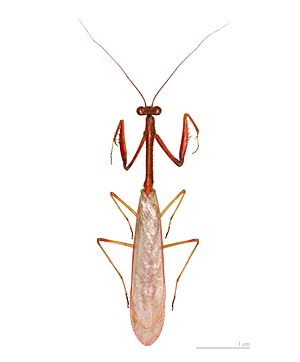Parastagmatoptera flavoguttata facts for kids
Quick facts for kids Parastagmatoptera flavoguttata |
|
|---|---|
 |
|
| Scientific classification | |
| Synonyms | |
|
Parastagmatoptera flavoguttata is a fascinating species of praying mantis that belongs to the Mantidae family. These amazing insects are known for their unique appearance and hunting skills. The name flavoguttata comes from Latin words meaning "yellow-spotted," which likely describes its markings.
Contents
What is a Praying Mantis?
Praying mantises are a group of insects famous for their distinctive front legs. These legs are bent in a way that looks like they are praying. However, they use these powerful legs to quickly catch their prey!
Hunter's Tools
Mantises are expert hunters. Their front legs are covered in sharp spines, perfect for gripping other insects. They also have a triangular head that can turn almost 180 degrees. This helps them spot prey from many angles.
Amazing Camouflage
Many mantises are masters of disguise. They often blend in perfectly with their surroundings. Some look like leaves, others like twigs or flowers. This helps them hide from predators and ambush their prey.
Where Parastagmatoptera flavoguttata Lives
While specific details about Parastagmatoptera flavoguttata's exact home are still being studied, most praying mantises live in warm, tropical, and subtropical areas. They can be found in various habitats, including forests, grasslands, and even gardens.
Finding a Home
These mantises prefer places with plenty of plants. This gives them good spots to hide and hunt. They might live on trees, bushes, or tall grasses.
What Do Mantises Eat?
Parastagmatoptera flavoguttata, like other praying mantises, is a carnivore. This means it eats other animals. They are skilled predators that mostly hunt other insects.
A Hunter's Diet
Their diet usually includes flies, crickets, moths, and grasshoppers. Some larger mantis species can even catch small lizards, frogs, or birds! They wait patiently for prey to come close, then strike with lightning speed.
Life Cycle of a Mantis
The life cycle of Parastagmatoptera flavoguttata involves several stages, similar to other mantises. It starts as an egg and grows into an adult.
From Egg to Nymph
A female mantis lays her eggs in a protective case called an ootheca. This case is often attached to a twig or plant stem. Inside, the eggs are safe from harsh weather and some predators. When the eggs hatch, tiny baby mantises, called nymphs, emerge.
Growing Up
Nymphs look like smaller versions of adult mantises but do not have wings yet. As they grow, they shed their outer skin multiple times in a process called molting. Each time they molt, they get a little bigger and closer to their adult form.
Adult Life
After several molts, the nymph becomes an adult mantis. Adult mantises have fully developed wings (if their species has them) and are ready to reproduce. Their main goal as adults is to find a mate and continue the life cycle.
Interesting Facts About Mantises
- Mantises are the only insects that can turn their heads almost all the way around.
- They have excellent eyesight, which helps them spot prey from a distance.
- Some cultures consider mantises a symbol of stillness or meditation because of their "praying" posture.
See also
 In Spanish: Parastagmatoptera flavoguttata para niños
In Spanish: Parastagmatoptera flavoguttata para niños

